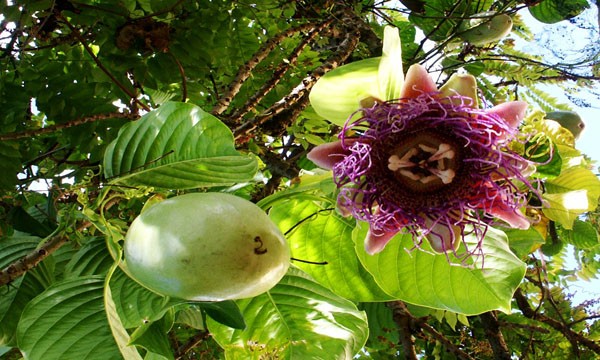- Overview
Granadilla Vine in a 3 Gallon Container. Vigorous vine with light to medium green heart shaped leaves. 3 to 4 inch blooms. Large high quality fruit with thin shell; white sweet pulp. Performs well in areas that don't freeze. Also does well in a cool greenhouse. In Hawai'i it grows best at higher elevations.
Description
Origin and Distribution
Varieties
Pollination
Climate
Soil
Propagation
Culture
Harvesting And Yield
Pests and Diseases
Food Uses
Toxicity
Medicinal UsesThe largest fruit in its genus, the giant granadilla, Passiflora quadrangularis L. (syn. P. macrocarpa M.T.Mast.), is often called merely granadilla, or parcha, Spanish names loosely applied to various related species; or it may be distinguished as granadilla real, grandadilla grande, parcha granadina or parcha de Guinea. In El Salvador, it is known as granadilla de fresco or granadilla para refrescos; in parts of Colombia, it is badea or corvejo; in the State of Tachira, Venezuela, badea; in Bolivia, granadilla real or sandía de Pasión. In Brazil, it is maracuya-acu, maracuja-assu, maracuja silvestre, maracuya grande, maracuja suspiro, maracuja mamao, or maracuja de caiena. In Surinam, it is grote or groote markoesa; in Peru and Ecuador, tumbo or tambo. In the Philippines, its local names are parola, kasaflora, and square-stemmed passion flower. To Indonesians, it is familiar as markiza, markoesa, markeesa, or manesa, and to the Malays, timun belanda, marquesa or mentimun. In Thailand, it is su-khontha-rot; inVietnam, dua gan tay, or barbadine, the French name.
Description
The vine is fast-growing, large, coarse, herbaceous but woody at the base, arising from a fleshy root that becomes enlarged with age, and climbing trees to a height of 33 to 50 ft (10-15 m) or even 150 ft (45 m) in Java. It has thick 4-angled stems prominently winged on the angles, and axillary tendrils to 12 in (30 cm) long, flanked by leaflike, ovate or ovate-lanceolate stipules 3/4 to 1 3/8 in(2-3.5 cm) long, sometimes faintly toothed. The alternate leaves are broad-ovate or oblong-ovate, 3 1/4 to 6 in (8.25-15 cm) wide, 4 to 8 in (10-20 cm) long; rounded or cordate at the base, abruptly pointed at the apex, sometimes toothed near the base; thin, with conspicuous veins sunken on the upper surface, prominent beneath. The solitary, fragrant flowers, up to 4 3/4 or 5 in (12-12.5 cm) wide, have a bell-shaped calyx, the 5 sepals greenish or reddish-green on the outside, white, pink or purple inside; the 5 petals, to 1 3/4 in (4.5 cm) long, white-and-pink; the corona filaments 2-ranked, to 2 3/8 in (6 cm) long, purple-and-white below, blue in the middle, and pinkish-blue above, around the typical complex of pistil, style and stigmas.
The pleasantly aromatic, melon-like fruit is oblong-ovoid, 4 3/4 to 6 in (12-15 cm) wide, and 8 to 12 in (10-30 cm) long; may be faintly ribbed or longitudinally 3-lobed; has a thin, delicate skin, greenish-white to pale- or deep-yellow, often blushed with pink. Beneath it is a layer of firm, mealy, white or pink flesh, 1 to 1 1/2 in (2.5-4 cm) thick, of very mild flavor, and coated with a parchment-like material on the inner surface. The central cavity contains some juice and masses of whitish, yellowish, partly yellow or purple-pink, sweet-acid arils (commonly referred to as the pulp), enclosing flattened-oval, purplish-brown seeds to 1/2 in (1.25 cm) long.
Origin and Distribution
The giant granadilla is generally agreed to be a native of tropical America, though the actual place of origin is unknown. It was growing in Barbados in 1750 and is present in several other Caribbean Islands and in Bermuda. It is commonly cultivated, and sometimes an escape from cultivation or truly wild, from Mexico to Brazil and Peru. At some point in the 18th Century, it was introduced into Malaya, where it thrives in both the north and the south. In Vietnam, it is limited to the southern half of the country. Perhaps it had reached Indonesia earlier, for it is more common and even naturalized there. It is also cultivated in the lowlands of India, Ceylon and the Philippines; in tropical Africa, and throughout Queensland, Australia. In tropical North Queensland it has run wild, growing lushly in jungle areas. It flourishes and fruits heavily especially in the Cairns district. It was being grown in Hawaii in 1888 and by 1931 had become naturalized in moist places. The United States Department of Agriculture received seeds from Trinidad in 1909 and the vine is very occasionally planted in southern Florida, but is too cold-sensitive to survive in California.
Varieties
There are various strains producing fruits of different sizes and quality. Wester stated that some are insipid, while one of superior flavor had originated at Cotabato. One strain with especially large fruits and good flavor was formerly considered a separate species (P. macrocarpa), but it hybridizes readily with smaller strains and there are intermediate types. An ornamental form, 'Variegata', has leaves splashed with yellow.
Pollination
The vine may produce few or no fruits in a dry atmosphere, or in the absence of insect pollinators. Also the pollen may ripen before the stigma is ready to receive it, and, at times, bees may steal the pollen too early in the morning. Hand-pollination is regularly practiced in Queensland and has been successful in limited experiments in Florida. It should be done in the late morning, no later than 4 to 6 hours after the flowers open.
Climate
The ideal climate for the giant granadilla is one that is truly tropical, warm both day and night, with little fluctuation, and with high humidity. It is grown between 700 and 1,500 ft (213 and 457 m) elevations in Jamaica and Hawaii, and up to 3,000 ft (914 m) in India; to 5,000 or, at most, 7,200 ft (1,800 or 2,200 m) in Ecuador. Vines several years old have been killed by winter cold on the Riviera.
Soil
For maximum growth and productivity, the vine requires deep, fertile, moist but well-drained soil. Australians have observed good growth on volcanic, alluvial, and sandy soil, and even decomposed granite. Vines planted in highly alkaline situations in Israel have died after evidencing acute chlorosis.
Propagation
The giant granadilla grows readily from seeds, which germinate in 2 to 3 weeks and the seedlings can be set out when 6 to 12 in (15-30 cm) high. Cuttings of mature wood 10 to 12 in (25-30 cm) or even 2 to 3 ft (.6-.9 m) long, are partially defoliated and deeply planted in well-watered sand. There will be sufficient vegetative growth and root development to permit transplanting in 30 days. Air- or ground-layers are also satisfactory.
Culture
In commercial plantings in Indonesia, the vines are set 6.5 to 10 ft (2-3 m) apart each way. When the plants reach about 6.5 ft (2 m) in height, they must be trained to a strong, horizontal trellis. Pruning may be necessary if the growth becomes too dense. Regular applications of fertilizer high in organic matter, and copious watering are necessary.
Harvesting And Yield
In Indonesia and Queensland, a productive vine will fruit more or less continually all year and the annual yield may range from 25 to 35 fruits in the larger types to 70 to 120 fruits in medium to small types. Venezuelan horticulturists report that their main blooming period is May to October and the fruits ripen in 62 to 85 days from flower-opening, the crop being harvested mainly from July through October. The yield of 2- to 3-year-old vines varies from 16 to 50 fruits. The fruits are ready for harvesting when the skin becomes translucent and glossy and is beginning to turn yellowish at the apex. It is clipped from the vine. Very careful handling and packing are essential.
Pests and Diseases
Young plants in nurseries may be severely defoliated by Disonycha glabrata in Venezuela.
In Queensland, the principal pest of the giant granadilla is the green vegetable bug, Nezara viridula, which punctures young fruits and sucks out the juice, causing them to wither and fall; or hard lumps will form in the flesh. To avoid damage by fruit flies, the fruits are sometimes bagged.
Leaf spot, from fungal infection, occurs occasionally in Queensland but it is considered of little importance. Stem-end rot in East Africa has been attributed to the fungus, Botryodiplodia theobromae.
Food Uses
The flesh of the ripe fruit, with the inner skin removed, is cut up and added to papaya, pineapple and banana slices in fruit salads, seasoned with lemon or lime juice. It is cooked with sugar and eaten as dessert, or is canned in sirup; sometimes candied; but it is so bland that it needs added flavoring. In Indonesia, the flesh and arils are eaten together with sugar and shaved ice. Australians add a little orange juice and usually serve the dish with cream. They also use the stewed flesh and raw arils together as pie filling. The whole arils can be eaten raw without removing the seeds.
Jelly can be made from the unpeeled flesh boiled for 2 hours and the pulp simmered separately. The juice strained from both is combined and, with added sugar and lemon juice, is boiled until it jells.
The pulp (arils) yields a most agreeable juice for cold drinks. It is bottled in Indonesia and served in restaurants. Wine is made in Australia by mashing several of the whole ripe fruits, adding sugar and warm water and allowing the mix to ferment for 3 weeks, adding 2 pints of brandy, and letting stand for 9 to 12 months.
The young, unripe fruit may be steamed or boiled and served as a vegetable, or may be cut up, breaded and cooked in butter with milk, pepper and nutmeg. In Java ripe fruits are scarce because of squirrels and other predators.
The root of old vines is baked and eaten in Jamaica as a substitute for yam.
Food Value Per 100 g of Edible Portion (Flesh)*Thick Flesh
Arils and Seeds
Moisture
94.4 g
78.4 g
Protein
0.112 g
0.299 g
Fat
0.15 g
1.29 g
Crude Fiber
0.7 g
3.6 g
Ash
0.41 g
0.80 g
Calcium
13.8 mg
9.2 g
Phosphorus
17.1 mg
39.3 mg
Iron
0.80 mg
2.93 mg
Carotene
0.004 mg
0.019 mg
Thiamine
0.003 mg
Riboflavin
0.033 mg
0.120 mg
Niacin
0.378 mg
15.3 mg
Ascorbic Acid
14.3 mg
*According to analyses made in El Salvador.
Toxicity
The leaves, skin and immature seeds contain a cyanogenic glycoside. The pulp contains passiflorine and, if indulged in excessively, causes lethargy and somnolence. The raw root is said to be emetic, narcotic and poisonous.
Medicinal_Uses
The fruit is valued in the tropics as antiscorbutic and stomachic. In Brazil, the flesh is prescribed as a sedative to relieve nervous headache, asthma, diarrhea, dysentery, neurasthenia and insomnia. The seeds contain a cardiotonic principle, are sedative, and, in large doses, narcotic. The leaf decoction is a vermifuge and is used for bathing skin afflictions. Leaf poultices are applied in liver complaints. The root is employed as an emetic, diuretic and vermifuge. Powdered and mixed with oil, it is applied as a soothing poultice. - Features
weight: 9.99 lbs : - ReviewsThere is no reviews yet...Be the first!
Be the first to write a review of this product!



